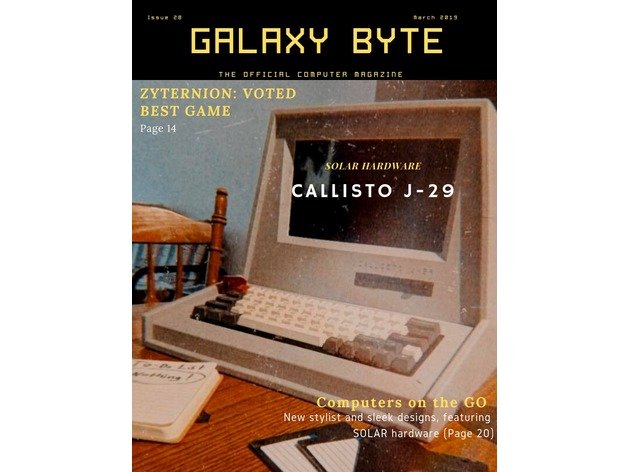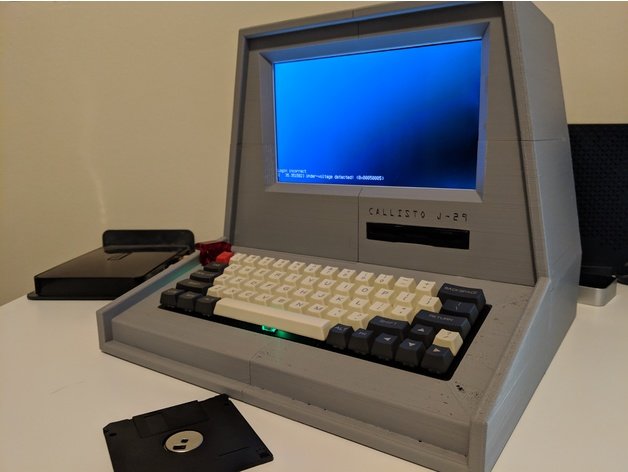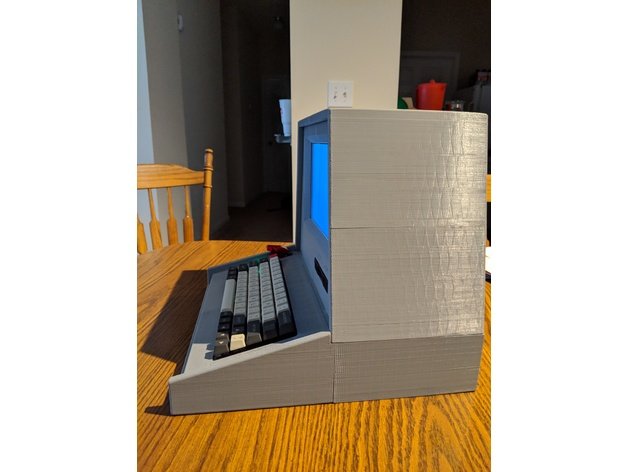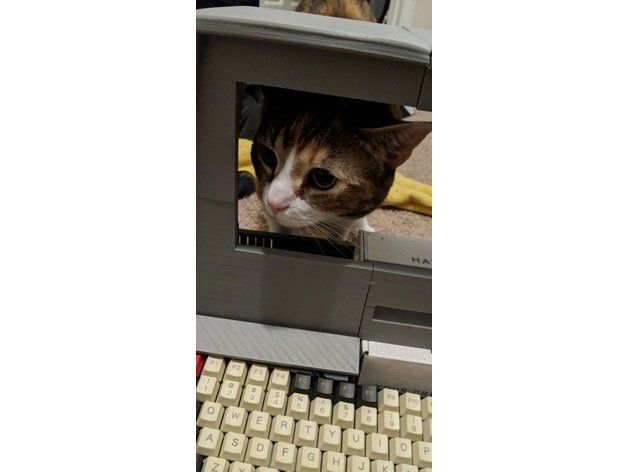Computer with terminal-style drive from Fallout

The author of this development is not intended to exactly repeat the terminal from a particular game of the Fallout series. It turned out, rather, a free paraphrase, but beautiful. And he “grunts” with a real drive and reads and writes real floppy disks.
The future is now
')
Introducing the first home computer series Jupiter - Callisto J-29 (Callisto - one of the satellites of Jupiter - translator) .
The latest Z-29 processor with a monstrous 1 MHz clock frequency will provide you with the features * that will last long in our changing world.
Just imagine how Callisto J-29 will help you at home and at work. With the appropriate software, he can do anything - from calculating the family budget to teaching children to mathematics.
In the evening you can relax by playing one of the pre-installed interesting games in the Python language.
Monoblock computer
You do not need to choose a balanced combination of components. CRT, drive, keyboard and 32-bit computer placed in a single monoblock case.
1.44-megabyte storage
Built-in 3.5-inch drive provides quick access to your programs and data. You will be on the crest of a wave in the world of modern drives. Say no to a loss of information forever.
So, if you are looking for a home personal computer system, you should look at Callisto J-29.
Meet at the nearest Circuit City store.
Only $ 3895. Productivity is huge, the price is not.
...
Or just print yourself the same.


Integrating the Raspberry Pi into the keyboard designed for it and thereby obtaining a form factor similar to home computers of the eighties is great, but the author of this design wanted to make a candy bar like the TRS-80 model 3 or Minitel terminals. Monoblocks with an external keyboard like the same TRS-80, but models 2, or Sparks-226, seemed to him to look too modern. Built, and no half measures!
The most important part of the design is the keyboard, which is similar to a vintage one. Keyboards with button mechanisms in blue cases are quite inexpensive and available on Amazon.
Monitors with the required diagonal are either too expensive or too thick. But it was still possible to find a model that is suitable for both parameters on the same Amazon. The author decided not to disassemble the monitor, but to design the model so that it fits with the case. From the translator: figure out how to cool, here Pikachu062 with its inimitable “without a cooler will burn” may be right.
The easiest way was to get the drive. USB drives are widespread and inexpensive.
The computer itself is the Raspberry Pi model 3 B +.
Components:
Keyboard - choose the option with the mechanisms of the buttons in blue cases.
Monitor , equipped with HDMI-cable. Currently sold out (appeared again, but the translator went up in price). Choose the 10.1-inch option. Having remade model for the press, it is possible to adapt the LCD monitor from POS, having completed it with the converter HDMI-VGA.
"Malinka" .
Disk drive Works with the "Malinka" better than the previous model.
Substrate for 3D printing .
Superglue .
Hardware M3x10 mm .
PLA filament .
USB hub with power .
Additionally:
Floppy disks
Switch with a lid - this is in Fallautian style.
Retro key caps .
Memory card.
Power cord "raspberry".
USB extension cable .
Connector for two RJ45 plugs .
The print of the case (there are many files and they are here ) will take two filament reels! If significant strength is not required, you can fit into one. Printing will take from 10 to 18 hours. Get great flat parts. On the printer table, they did not hold - they crawled, the substrate helped, everything worked out right away.
After each print, clean the table with isopropyl alcohol and microfiber.
Print the first layer, warming the table to 90 ° C, then reduce its temperature to 55 ° C.
Details should not be bent and glued like glue.
How to make parts strong but inexpensive? A 100% fill will not work. It takes a lot of perimeters. Three to four perimeters on each side with a small filling - and the detail is durable. Here are the options for the Cura:
Layer thickness: 0.20 mm
Shell thickness: 1.2 or 1.6 mm
Thickness of the upper and lower layers: 0.6 or 0.8 mm
Filling: 10%
Print speed: 55 mm / s
Nozzle temperature: 220 ° C
Table temperature: 90 ° C for the first layer, 55 ° C for the next
Support: everywhere
Supports will not increase noticeably the print time, but the details will not crack in the installation locations of fasteners, switches, drives and keyboards.
For the author, this is the first posting on the Thingiverse. Praise and criticism are accepted. Feel free to modify the model. The author plans to develop several more cases for computers and peripherals.
After assembly, connect the parts with pins to make sure they fit together. Check if the keyboard and monitor are suitable for their compartments. Glue the half panel to the keyboard, the pins will hold them in the correct position until the glue hardens. Do the same with the halves of the bottom, and four quarters of the panel for the monitor glue together in two halves. Many small details turned into four large ones. Glue the keyboard panel to the bottom, then the bottom of the monitor panel to the base, and the top of the monitor panel to the bottom. Glue together four quarters of the back wall. Leave the case alone for 24 hours. Place the keyboard, monitor, drive, RJ-45 plug connector and USB extension cable in place. They will stick without glue. Screw the M2.5 or M3 hardware “raspberry”, and after you connect everything - and the back wall.
Thread the USB hub power cable through the hole in the back wall. Five-volt power supply, take a two-amp. Power all components except the drive and keyboard from the hub. Connect the drive and keyboard to the "raspberry", from it they will also eat. Connect the monitor with the “raspberry”. Make sure that each time you turn on the drive makes a short sound.
The switch can both control the “raspberry” programmatically via GPIO, or simply turn off the power of the entire hub.
Although the simulations of the Fallout terminals exist, the author decided that the Linux console already looked in Fallout enough.
Kote also thinks so.

Source: https://habr.com/ru/post/445110/
All Articles